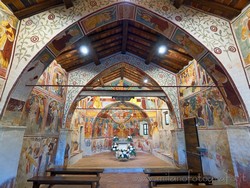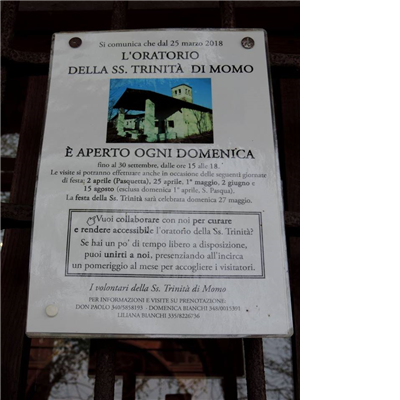|
Momo (Novara, Italy): Oratory of the Holy Trinity
|
|
|
Show an other place around Milan worth a visit: |
 The oratory of the Holy Trinity of Momo is a treasure of art and history that only since a few years is gaining the fame it deserves. Located just over one km north of the town of Momo, in ancient times it was located along one of the routes traveled by pilgrims on their way to Santiago de Compostela, Rome and Loreto. This is confirmed by the presence, inside, of frescoes depicting the scene of the Disciples of Emmaus, with Jesus in the shoes of a Santiago pilgrim, of the Carriage of the Holy House in Loreto and of the Pilgrims' Housing as an example of a work of mercy. The oratory of the Holy Trinity of Momo is a treasure of art and history that only since a few years is gaining the fame it deserves. Located just over one km north of the town of Momo, in ancient times it was located along one of the routes traveled by pilgrims on their way to Santiago de Compostela, Rome and Loreto. This is confirmed by the presence, inside, of frescoes depicting the scene of the Disciples of Emmaus, with Jesus in the shoes of a Santiago pilgrim, of the Carriage of the Holy House in Loreto and of the Pilgrims' Housing as an example of a work of mercy.
The small church was probably built around the year 1000 by the Cluniac monks of one of the two Cluniac abbeys that existed in the area at that time, one female and one male. As evidence of this, the dedication to the Trinity, dear to the Cluniacs, and the presence of a Cluniac nun in evidence in the fresco of the Last Judgment.
The dating of the construction to the year 1000 is also confirmed by the structure of the apse and of the base of the bell tower. The materials used are river pebbles, interspersed with partially cooked bricks and mortar.
Excavations carried out in the nave during the 1998 restoration brought to light funerary urns of Celtic origin. This suggests that the site already housed religious buildings in the pre-Christian period.
At the beginning of the fifteenth century the interior was modified with the division of the nave into three spans by the addition of the two pointed arches supporting the wooden and tile roof.
The cycle of frescoes that occupies the internal surfaces starting from the second span was painted at the end of the fifteenth century, by the Cagnola workshop.
At the beginning of the sixteenth century the southern exterior wall was frescoed. On it were painted the figures of Sant'Antonio Abate, San Giulio, San Cristoforo and San Grato. A chapel was also built close to the apse (Fig. 5), to incorporate the venerated fresco of the Virgin of the Nativity painted on the external wall of the apse. The fresco is from the late fifteenth century.
In the middle of the sixteenth century the church was enlarged by a span on the façade side. Moreover the large portico still visible today leaning against he facade was added.
As evidence of this extension, the fact that the frescoes on the walls of the first span are from the sixteenth century (one from 1548), again from the Cagnola workshop, but in this case by Sperindio Cagnola.
The importance of the small church is evidenced by the fact that in 1592 Pope Clement VIII granted the plenary indulgence to those who visited it.
The bell tower was completed only in 1597 with the insertion of the bell in the belfry.
In the seventeenth century, a wooden beam with the words "Non veni mittere paceme sed gladium" was added to the arch. Unfortunately the intervention caused the loss of a part of the frescoes on the under-arch.
It should be emphasized that the façade was not completed until 1610. Previously the church was closed only by a gate.
Finally, in 1620, an additional body was added next to the church to house a hermit, guardian of the church with the task of collecting alms. At his disposal a well and an orchard.
The frescoes
The main cycle of frescoes (structured in images divided into panels, very similar to modern comics) is dedicated to the history of salvation, The cycle begins at the apse, where the Trinity is represented in a multicolored almond and supported by five angels.
Above it two musician angels, under it, in a band, the twelve apostles. At the bottom, finally, the representation of the Seven Works of Mercy.
Along the walls there are 13 episodes of Jesus' childhood and 23 of his passion, divided by white or red bands.
Of course, there is also a representation of the Last Judgment, divided into five panels (Judgment, Limbo of children, Limbo of the fathers, Purgatory and Hell) and the Annunciation on the triumphal arch.
On the sub-arches, finally, representations of saints.
The frescoes in the main cycle are late Gothic and highlight the typical stylistic elements of the Cagnola workshop: floors made of red pebbles, frequent use of brocade to make dresses more elegant and bring out the more important characters, thrones of the Virgin adorned with plant motifs, very dramatic representation of the wounds of Jesus in the scenes of the passion, the halo of Christ with the golden part that traces curious "mouse ears".
In general the representations are rather flat, with very defined lines and chromatic areas, so that the hair is represented to appear almost like wet hair in which the comb has just passed.
The frescoes in the first span and those outside appear instead already more influenced by the new Renaissance ways, with more nuanced colors and softer lines.
Here below in the picture some useful info to visit the oratory. For those who want to, it is available inside to buy a photo book in which all the frescoes in the church are presented.
Finally, the church offers the convenience of having right next to it a trattoria where to eat at a good price!

Categories: Places of historical value of artistic value
SP229, 28015 Momo NO |
Further pictures of Oratory of the Holy Trinity in the section Photography |